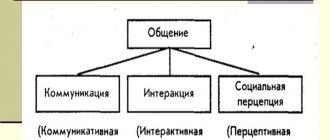Man is a social creature and constantly interacts with other people throughout his life. Without communication, life and activities of any society together are impossible. The concept of communication means the establishment and development of relationships between people and groups, the creation of interpersonal contacts in the process of joint life activities. Scientists have established what functions communication performs.
Business conversation
What is communication
Communication is a process of interaction between people, a way of establishing contact for the exchange of emotions, information, ideas, thoughts between interlocutors. With the help of communication, people show their sympathy or dislike and express their attitude towards another person. Everyone’s communication abilities are different; they depend on the individual’s intellectual development and skills of interacting with society—communication skills.
Communication using articulate speech is one of the main distinguishing features of humans from animals. Animals also know how to communicate, but their interaction occurs through a system of sounds, vibrations, and gestures.
This is interesting! Some species of exotic fish communicate with each other by changing their color, ultrasound, and making sounds similar to rumbling, birdsong, and drumming.
A person develops communication skills from early childhood. In the first years of life, it becomes a way to tell parents about your wants and needs. Over time, thanks to communication, a person can not only convey his feelings, but also understand those around him, learn about their experiences, desires, and interests.
How to communicate with impossible people
Difficult people require a special approach during conversation. If you need to contact an unpleasant person, you can minimize the receipt of negative emotions using 5 basic rules:
- You should not take your opponent’s criticism or advice that you haven’t asked for personally.
- If your interlocutor likes to interrupt, you should not allow him to do so. This requires politely explaining to the person that his arguments will not be heard until the speech is finished.
- If the interlocutor does not want to talk, but you need to get an answer from him, in this case the best communication is to briefly state the essence of the question.
- We should not forget about the ability to listen to your opponent. Thanks to an attentive attitude towards the interlocutor, respect for his words and thoughts will be visible.
- There is no need to teach a person to communicate if he does it somehow wrong. Each individual has his own way of speaking. Therefore, an evaluative conversation will only irritate.
Communication is the key to the whole world. Careful study of the operating instructions and proper use will make it easier to achieve your goals.
Variety of forms of communication
There are many varieties and forms of communication. By means of communication, verbal, non-verbal, direct, and indirect communication are distinguished.
- Verbal communication is the interaction of people using speech. An individual can talk with one or several interlocutors at the same time. Verbal communication can take the form of dialogue (interpersonal communication between people) or monologue (speech by one person). With the help of words, you can not only convey information, but even change the life and destiny of another person.
Important! It is not for nothing that there are many sayings on the topic of the significance of the spoken word (“The word is not a sparrow” and others). With the help of words you can start a war, make peace, generate hope, and inspire to accomplish useful deeds. The word is a real weapon in a person’s arsenal, but this weapon can become deadly, because it’s not for nothing that they say that you can kill with a word.
The ability to achieve mutual understanding depends on the ability to competently and beautifully express one’s thoughts into words. By a person’s speech you can understand whether he is smart or stupid, educated or illiterate, kind or evil.
- Nonverbal communication is contact between people, which is carried out through a system of gestures, actions, body position, and facial expressions. Even without words, you can understand what a person is thinking about, his mood, by looking at his face, posture, and noticing involuntary gestures.
This is interesting! Psychologists know how to decipher human gestures and reveal their hidden meaning. For example, crossed arms over the chest may indicate a reluctance to continue the conversation, or the interlocutor’s closed nature. Hands in pockets during a conversation also indicate a desire to hide something, shyness and closedness towards the interlocutor.
By looking at a person you can understand his mood, desire to start a conversation or avoid it. Young children are well versed in non-verbal communication on an intuitive level; they only need to look at their parents to understand whether it is worth talking about a broken vase or asking to buy a new toy.
- Direct communication is a form of verbal or non-verbal communication carried out directly, eye to eye, between interlocutors.
- Indirect is communication that occurs through special means of transmitting information: television, books, radio, the Internet. With such communication, there is no immediate feedback from the interlocutor. For example, when watching the president's address on television, viewers cannot establish immediate feedback with their interlocutor.
Indirect communication provides humanity with the opportunity to accumulate and transmit its experience, to preserve its thoughts and words for centuries. So a writer who died 300 years ago still communicates with modern schoolchildren through his works.
In addition, forms of interpersonal communication are distinguished, depending on its goals.
- Business communication (formal) - aimed at establishing cooperation between people engaged in joint work activities. It occurs according to certain rules, according to the norms of business etiquette.
- Informal communication – used for personal contacts between close interlocutors (relatives, friends, acquaintances). It allows you to share feelings, experiences and emotions in a free form, without any rules or restrictions.
- Educational communication – its goal is to influence another person, to develop in him the desired qualities and abilities. A striking example is the communication between a teacher and students.
The types, forms and means of communication are diverse, but they have one goal - to establish mutual understanding between people.
Types and levels of communication
If we characterize the forms more precisely, we will get such a concept as “ types of communication .” This classification describes the relationship, giving it bright and specific features:
- Primitive - when people look at the interlocutor as an object on whom they label “can be used / not needed.” And in accordance with this, they try to improve relationships, or they leave the dialogue, avoid it.
- Formal-role – when the method of communication, its essence and content is established. The social function of a person in a particular group plays an important role.
- “ Contact of masks ” - the usual hypocrisy (what is this?), insincerity or simply politeness is used without the desire to understand the interlocutor. The connection is formed exclusively on a superficial and formal level.
- Business - during a conversation, they focus on the matter, the issue. But at the same time, they can pay attention to some of the partner’s traits and take into account their character. Everything in order to achieve your goal.
- Manipulative - different methods are used to get benefits from the interlocutor (ostentatious indifference, false haste, assertion of authority).
- Secular - people do not express their real point of view, but simply talk about nothing. As a rule, the purpose of such chatter is to meet profitable people and to show off oneself to others.
- Spiritual – when the interlocutors know each other’s personalities well. When communicating, they take into account interests, preferences, and can suggest reactions to words.
Types provide a more diverse description of communication. Levels describe the attitude of people within the framework of communication. Researcher V.N. Sagatovsky highlights:
- The level of manipulation is the attitude and treatment of people as an object to achieve a goal.
- The level of “ reflexive play ” - a person in a dialogue understands that both have plans for each other. But they are trying to show that they just have normal communication without pitfalls.
- Level of legal communication - the behavior of the interlocutors is coordinated, taking into account specific rules and norms.
- Level of moral communication - the relationship arises on the basis of the unity of internal qualities.
Communication functions
Communication performs the following important functions in human society:
- Information exchange. People get to know themselves and the world around them faster and better thanks to the opportunity to share their acquired knowledge and accumulated experience with each other.
- Inspiration to activity. With the help of communication, people encourage others to take certain actions, inspire them to fulfill their duties and help society.
- Conveying emotions. Through various means of communication, people exchange their experiences, feelings, and impressions with each other.
In addition, communication performs several more important functions: establishing contacts between people, achieving mutual understanding, forming and developing personality.
The establishment of positive or negative feedback between interlocutors depends on how successfully the communication process occurs. Communication often leads to misunderstanding and the emergence of conflicts on this basis. You can get out of the conflict by mutual concessions (compromise) or by avoiding further contact or conversation with the instigator of the conflict.
To ensure that as few conflicts as possible arise in society and that interlocutors respect and understand each other, etiquette was created as the basis for interpersonal communication.
Communication from the perspective of psychology
The term “communication” refers to different forms of interaction between people, which are carried out using various sign means, such as:
- facial expressions;
- symbols;
- images.
The desire to contact another person arises from the need to act together.
Significance in psychology
To clearly understand what communication is, it is necessary to consider the various definitions of the term. They will help to form a multifaceted understanding of this method of communication:
- Human communication is considered in psychology to be a complex and multifaceted process that is aimed at establishing and developing contacts between a group of people.
- According to the literature on the culture of communications, communication is a unique process of exchanging the results of spiritual and mental activity between people. This may include assessments, thoughts, feelings, judgments, attitudes.
- Communication is also a basic psychological need of a person, which contributes to the formation of personality. In the process of interpersonal contacts, the subjective world of one individual opens up to another. This allows a person to self-determinate and self-present himself in society.
Etiquette
The concept of etiquette is of French origin, since this word first appeared at the court of the French king Louis XIV. Louis sought to weaken the influence of the courtiers around him, the most noble and influential people in France. He came up with a whole set of rules for the behavior of the nobility in the presence of the king in order to show them his greatness, to rise above his subjects.
Sitting at the same table with the king, the courtiers discovered labels lying on each seat. They described how subjects should behave in the presence of the king. Over time, the set of rules was supplemented by countless and often meaningless regulations.
Today, etiquette is the rules of behavior accepted in society, while each specific society has its own rules.
This is interesting! Speech etiquette differs greatly from country to country. In Germany, it is customary to address only friends and family by name; others are called solely by their last name. In South Korea, it is not customary to shake hands when meeting; interlocutors avoid any touching of each other. In Italy, even unfamiliar people are affectionately called “Darling”, “Sweetheart”.
Speech etiquette refers to the rules governing interpersonal communication. It depends on the age of the interlocutor, the business or friendly environment, and the place of communication.
Speech etiquette and communication culture include a number of basic rules:
- It is necessary to greet your interlocutors when meeting, to say goodbye when parting;
- You cannot interrupt your interlocutor during a conversation;
- During a conversation, you should not wave your arms wildly, raise the timbre of your voice, or gesticulate excessively;
- During business communication, speech should be literate, free from filler words, calm and restrained;
- Seniors in age, rank, position and strangers should be addressed as “you”;
- The use of swear words is unacceptable, both in personal and business communication;
- You cannot talk with your mouth full, turning your back on the interlocutor and in every possible way showing him your disinterest in the conversation.
Compliance with the rules of speech etiquette is necessary in communication to create a friendly and welcoming environment and atmosphere during a conversation.
Concept
As you know, communication is inherent in a person as a social being. Without the latter, no interaction with other members of society can take place.
Definition 1
In general, communication is a specific process in which interpersonal interaction takes place. This process is determined by the needs of the subjects who interact and is aimed at satisfying these needs.
Communication is more important than ever in the modern world, as the amount of information increases. In addition, the number of “person-to-person” professions is rapidly growing.
Are you an expert in this subject area? We invite you to become the author of the Directory Working Conditions
Rhetoric
Successful interaction with society depends on the development of communication skills and experience. A high position in society requires a person to be able to express his thoughts beautifully. Many politicians, public figures, and business leaders were able to achieve heights of success thanks to their eloquence and fruitful communication with people. It is difficult to imagine a general, diplomat, or president who cannot speak competently.
Rhetoric is a science that teaches the art of beautiful and correct speech. It originated in the period of Antiquity and was very popular among the ancient Greeks and Romans. All male representatives of noble origin were taught the art of oratory so that in the future they could become successful politicians, orators, and military leaders.
Today, the ability to persuade, prove one’s point of view, and speak in front of large audiences is necessary for representatives of any public professions: journalists, teachers, TV presenters. Even without a natural talent for eloquence, you can learn this thanks to the methods of the science of rhetoric.
Similar works
- Psychology of communication: functions of communication, errors in perception
- Psychology of communication: definition, types and functions
- Psychology of communication: concept, types and functions
- Psychology of communication: perception in the process of communication
- Psychology of communication: concept, types, definition
- Psychology of communication: disclosure of the concept, types and functions of communication
- Psychology of communication (Option No. 10)
- Psychology of communication: types, concept of communication
- Psychology of communication (communication functions and test)
- Psychology of communication: types and functions of communication
- Psychology of communication: concept, types and function of communication
- Psychology of communication
- Psychology of communication: the role of perception in the communication process
- Psychology of communication: concept, errors of perception
- Psychology of communication: types and functions, error of perception
- Psychology of communication
How to develop eloquence
Anyone, if desired, can learn to express their thoughts competently and beautifully, present information in an engaging manner, and speak in front of a large audience without fear. In order to develop eloquence, you need to use the methods of rhetoric:
- A speech in front of a large audience is thought out in advance. You need to make a short outline of the story, practice several times in front of the mirror;
- Any opinion put forward by the speaker (storyteller) must be confirmed with the help of logical arguments (they also need to be thought out in advance) or examples from life;
- You need to present your thoughts sequentially, leaving listeners a little time to think about the content of what was said;
- To attract the attention of the audience, you need to use different intonations, highlight important thoughts in a special voice;
- A voice that is too loud quickly tires and distracts attention, while a quiet voice does not allow listeners to concentrate;
- It is better to avoid monotonous speech and too abstruse, long phrases; they “lull” the audience’s attention.











